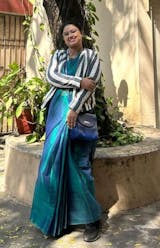Article: Ajrakh

Ajrakh
AJRAKH….A journey from the Indus Valley Civilization to the future of Sustainable Fashion.
And then he set out on a journey
To use all the skills he had inherited and learned
To give nothing but what’s perfect..
Little did he know that
Perfection is nothing but a mindset!!!
So let’s get on this journey today, to understand all about the craft Ajrakh, which is believed to have been practiced 4000 years ago, during the Indus Valley Civilization. Strong evidences have been discovered strengthening the fact that this handicraft might be one of the oldest form of textile printing techniques to hold relevance till date and has the potential to become more popular with time and the right consumer mindset.
Trivia- The bust of a priest king, where half of his chest can be seen covered with a shawl, the print on which strongly resembles Ajrakh, is believed to be excavated from the sites of Mohen Jo Daro,(currently exhibited in the National Museum of Pakistan) and serves as a concrete evidence for the above statements.

Revival of Ajrakh 400 years ago
Around 400 years ago in Sindh, Pakistan where Ajrakh was originally practiced, the craftsmen from the Khatri Community moved to Dhamadka, Kutch. Unfortunately Gujarat was hit by an earthquake in 2001 which led the community of craftsmen to move base 43 kms away from the main site of Dhamadka, this movement led to the establishment of Ajrakhpur, where almost all the families use the craft of Ajrakh as a mean of livelihood.
Ajrakh is now widely practiced in Sindh in Pakistan, Ajrakhpur in Kutch and Barmer in Rajasthan. A clear difference in designs and patterns can be seen depending on the place the fabric has come from.
What’s there in a Name?
Though there is no solid reference, but the name Ajrakh is believed to be derived from an Arabic word “Azrak” meaning Blue which is the defining colour in an authentic Ajrakh fabric.
If the colloquial context is to be believed, the name came as a result of the tedious and time taking process of making an Ajrakh and always having to wait a day before proceeding with the next step, therefore “Aaj Rakh” or “Put it aside for today”
Another story goes like, a Mughal King in those times liked his ajrakh printed breadspread so much that whenever the servants came to change it he asked them to let it be there for another day and thus the term “aaj rakh”
Ajrakh is now becoming popular among the affluent class of society looking for a sustainable fashion wardrobe.
Wear an Ajrakh 365 days of the year
If we talk about the process of making an Ajrakh the authentic way, an authentic piece is still printed manually on both the sides and also on single side nowadays ,this technique of hand block printing requires immense skill and the rhythmic cohesion is almost tangible by just a glance at the fabric, till date the dyes used are all natural and eco friendly, and every fabric undergoes a rigorous 14 to 16 steps to come to life in the desired form. The more the gap between the next step the finer the results.
Trivia- The natural dyes make the fabric wearable all around the year by giving it a wax like characteristic, which helps the fabric to expand during summers making the fabric airy and breathable, and contract in winters thus keeping you warm.
Trivia- Ajrakh was originally worn by the Maldharis or cattle herders and they used to leave with their cattle before sunrise, as there was no electricity during those times it used to be difficult for them to differentiate between the inside and the outside of their clothes and thus the practice of printing the fabric on both the sides started.
We as consumers get so demanding and expect nothing but perfection from the artisans, as we are paying them money, but what we forget is that the final outcome is not only dependant on the skillset of the artisan but also on some other factors like climate, water resource, quantity and quality of it, and also if each of the step that goes in the making of an Ajrakh has been properly followed with the cooperation of the external factors too. Once we know the actual struggle that goes in making that one perfect fabric we will be much more flexible in the future.
Ajrakh in making…15+ steps and infinite amount of patience and skill for each fabric
It’s a tedious and time taking process and requires not only skill but patience and grace from God.
- Washing- The fabric that comes from the factory is washed multiple times and soaked in a mixture of castor oil, soda ash and camel dung to free it from any kind of impurities and starch, as it hinders the dying process.
- Drying and prepping for dying- Next step is to dry the fabric under the sun and then prep it for dying by treating it with Harde nut powder, the harde acts as a mordant and helps in the dying of the fabric
- Resist printing- The fabric is then printed with resist to prevent the dye colours from spreading at the place where they are not required. Resist is prepared with Lime, alizarin, alum etc.,
- Dye preparation using natural products- All the products used for dyes are natural like iron scraps, tamarind, jaggery and Madder root.
- The fabric is washed and dried every time it is dyed with a different color to remove the resist and dye residue and drying under the sun helps to deepen and solidify the colors for a brighter shade.
- Hand chiseled wooden blocks are used for the Minakari work as per the desired pattern, the designs are inspired by elements from nature. Widely used patterns are geometric, and floral motifs.
- The quantity and quality of water plays a crucial role in the final outcome, High content of minerals and iron in the water effects the brightness of the colors and often leads to blotching of the fabric.
- Once the dying, washing and drying is done for all the required hues, the fabric is boiled in water and once again washed and sun dried for the final outcome.
Threats to the art
The threats that have been for long been piercing the minds of the artisans, let us throw light on the major ones for you:
- Climate changes- Erratic rainfalls, sometimes excessive for few days, sometimes negligible, depleting water tables due to excessive agriculture and the ever increasing water crisis only intensifying with time is a major concern for the craftsmen and their families welfare and livelihood sustainability.
- Younger generations abandoning the craft- The apparent low return and non lucrative future of this craft with exhaustive struggle is making the younger generations of the artisans to choose and explore other options for livelihood. The artisans have been struggling for long to make both ends meet let alone affording a good education for their kids, looking at all this its only fair for the young ones to look out for greener pastures.
- Digital prints available in market for lesser price- The screen printing with machine and by hand on fabric has all the more reduced the already bleak market share of the handicraft artisans, consumers want products that are easy on the pocket and look good too, and don’t want to wait for a quality product to come along.
- Consumers ever increasing demand for perfection and variety- We as consumers are so spoilt for choices by fashion labels that we are almost blinded by the shine and accessibility of fast fashion and thus totally neglecting the dark aspect of it all, as consumers we demand perfection in return for our money n nothing less which is like putting up a man to compete with a bot.
- Challenges in keeping up with the changing market trends- Though these artisans are trying hard to keep up with the market demands, with the lack of proper resources and manpower its hard to match up-to the same n satisfy the customer.
YOUR JOB AS A CONSUMER
Be the change that you want to see in the world.
- Buy Authentic prints and pay full price rather than going for screen prints and cheaper imitations.
- Move towards sustainable fashion- Buying clothes that are made by using synthetic dyes on cheap non bio-degradable fabric, might be easy on your pocket but wont be easy on the climate for sure and we should choose to hold some accountability towards a better future.
- Always support small businesses making eco-friendly and sustainable fashion options available within the comfort of your home.
- Choose Imperfections over mechanization, Imperfect designs are a sign that it is the result of the hard work of a man and not a machine, acknowledge this and award them by paying full.
- Shop less but shop authentic and shop local.













